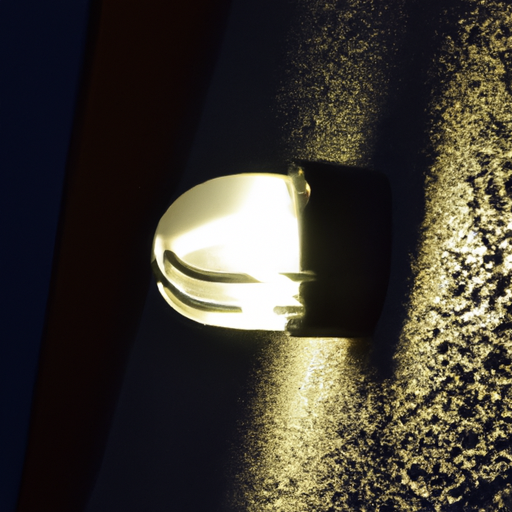The Ultimate Guide to Choosing the Best Home Security Lighting
In “The Ultimate Guide to Choosing the Best Home Security Lighting,” you’ll discover everything you need to know about selecting the perfect lighting system for protecting your home. From choosing the right type of lights to understanding their placement and functionality, this guide provides invaluable insights to enhance your home’s security. Explore the various options available and gain peace of mind knowing that you’ve made an informed decision to safeguard your loved ones and belongings.
Types of Home Security Lighting
Motion Sensor Lights
Motion sensor lights are an essential part of any home security system. These lights are triggered by movement and can instantly illuminate the surrounding area, deterring potential intruders. They are typically placed near entrances and walkways, and can also be used to light up dark corners of your property. Motion sensor lights are a great choice because they only turn on when needed, which helps conserve energy and prolong the lifespan of the bulb.
Floodlights
Floodlights are incredibly powerful and produce a wide beam of bright light. They are designed to illuminate large areas, making them ideal for lighting up your backyard or driveway. Floodlights can be either wall-mounted or installed on the ground and can be set to stay on continuously or be triggered by motion. They provide excellent visibility and are often used in combination with other security measures, such as surveillance cameras.
Spotlights
Spotlights are used to highlight specific areas or objects, such as the front entrance or landscaping features. They are focused and directional, allowing you to highlight key areas of concern. Spotlights can be mounted on walls, trees, or posts, and can be adjusted to achieve the desired angle and coverage. They not only provide functional lighting but also add an aesthetic touch to your home’s exterior.
Pathway Lights
Pathway lights are a great option to enhance the safety and security of your home. They are typically low-level lights that line your pathways and illuminate the way to your front door. Pathway lights come in various styles and designs, allowing you to complement the overall aesthetics of your outdoor space. They not only improve visibility but also create a welcoming ambiance for your guests.
Staircase Lights
Staircase lights are crucial for ensuring the safety of your family and visitors. They are usually installed in staircases, both indoors and outdoors, to prevent accidents and provide guidance. Staircase lights come in different forms, including recessed lights, step lights, and handrail lights. These lights not only serve a practical purpose but also add a decorative element to your home.
Factors to Consider When Choosing Home Security Lighting
Brightness
When choosing home security lighting, it’s important to consider the brightness of the lights. A bright light can effectively deter intruders and provide maximum visibility in dark areas. Look for lights with high lumen output to ensure they can adequately illuminate the desired area.
Coverage Area
Consider the size and layout of your property when selecting home security lighting. You want to ensure that the lights you choose cover all the key areas, such as entry points, driveways, and backyard. Take into account the range and angle of the lights to ensure proper coverage.
Power Source
Home security lighting can be powered by various sources, including electricity, solar power, and batteries. Each power source has its advantages and disadvantages. Electric-powered lights provide a reliable and consistent source of power, but may require professional installation. Solar-powered lights are energy-efficient and don’t require any wiring, but their performance may be affected by weather conditions. Battery-powered lights offer flexibility in terms of placement but may require more frequent battery replacements.
Installation
Consider the installation process when selecting home security lighting. Some lights may require professional installation, while others can be easily installed as a DIY project. Take into account your skill level and available time when determining the best option for you.
Lighting Control Options
Choose home security lighting that offers flexible lighting control options. This includes the ability to adjust the sensitivity of motion sensors, set timers, and integrate with other smart home systems. Having control over your lights allows you to customize your security setup and ensure optimal performance.
Placement and Positioning of Home Security Lighting
Front Entrance
The front entrance is a key area to focus on when it comes to home security lighting. Consider placing motion sensor lights near the front door to deter potential intruders and provide a well-lit entry for you and your guests. If you have a porch or steps leading up to the entrance, consider installing pathway lights or staircase lights to enhance visibility and safety.
Backyard and Patio
The backyard and patio are often overlooked when it comes to security lighting. However, it’s important to illuminate these areas to prevent unwanted guests from lurking in the shadows. Floodlights are an excellent choice for lighting up larger areas, while spotlights can be used to highlight specific features or objects of interest. Pathway lights can also be installed along walkways to ensure safe navigation in the dark.
Driveway
Proper lighting in the driveway area is essential for both security and convenience. Motion sensor floodlights are a popular option for illuminating driveways whenever there is movement detected. This not only deters potential intruders but also provides visibility for you and your family when arriving home at night.
Garage and Carport
The garage and carport are usually high-value areas that require good lighting. Consider installing motion sensor lights near these areas to deter thieves and provide easy access at night. Additionally, having well-lit surroundings enhances safety during vehicle entry and exit.
Windows and Entry Points
Windows and other entry points, such as backdoors or side entrances, should also be well-lit to discourage break-ins. Motion sensor lights or spotlights can be strategically placed to cover these areas. It’s important to ensure that windows are well-illuminated from both the inside and outside to discourage potential intruders.
Cost Considerations for Home Security Lighting
Initial Cost
When evaluating the cost of home security lighting, consider the initial upfront expense. This includes the cost of the lights themselves, as well as any additional installation materials or professional services required. Higher-quality lights may have a higher initial cost but can provide better performance and durability.
Operating Cost
Operating costs should also be taken into account when choosing home security lighting. LED lights, for example, are highly energy-efficient and can significantly reduce electricity bills compared to traditional incandescent bulbs. Solar-powered lights have no ongoing electricity costs but may have higher initial costs.
Maintenance Cost
Consider the maintenance requirements and cost of the lighting system. LED lights have a longer lifespan and require less frequent bulb replacements, leading to lower maintenance costs. On the other hand, traditional bulbs may need to be replaced more often, increasing maintenance expenses over time.
How to Choose the Right Bulb for Home Security Lighting
LED Bulbs
LED bulbs are the most popular choice for home security lighting. They are energy-efficient, have a long lifespan, and produce bright and focused light. LED bulbs also come in various color temperatures, allowing you to create the desired ambiance for your outdoor space. Additionally, LED bulbs are available in different shapes and sizes to fit your specific lighting fixtures.
Halogen Bulbs
Halogen bulbs are known for their bright and crisp light output. They offer excellent color rendering and can produce a powerful beam of light. However, halogen bulbs are not as energy-efficient as LED bulbs and have a shorter lifespan. They also emit more heat, which may not be ideal for certain outdoor lighting applications.
Incandescent Bulbs
Incandescent bulbs are the traditional choice for outdoor lighting, but they are becoming less common due to their low energy efficiency. While they are relatively inexpensive, they have a short lifespan and consume more electricity compared to LED or halogen bulbs. Incandescent bulbs also generate more heat, which can impact their performance in certain weather conditions.
Smart Bulbs
Smart bulbs offer advanced features and functionality for home security lighting. These bulbs can be controlled remotely using a smartphone or integrated with a smart home system. Smart bulbs often have adjustable brightness levels, color options, and scheduling capabilities. They provide the convenience of controlling your lighting settings from anywhere, enhancing the security and energy efficiency of your home.
Additional Features to Enhance Home Security Lighting
Timer and Schedule Settings
Many home security lights offer timer and schedule settings, allowing you to automatically turn them on and off at specific times. This feature can create the illusion of someone being home even when you’re away, deterring potential intruders. Setting a schedule for your lights also helps save energy by only keeping them on when needed.
Remote Control and Smartphone Integration
Some home security lights can be controlled remotely using a smartphone or other smart devices. This allows you to turn your lights on or off, adjust the brightness, or change the settings from anywhere, providing added convenience and security. Remote control and smartphone integration give you full control of your lighting system, even when you’re away from home.
Security System Integration
Integrating your home security lighting with your existing security system can provide an additional layer of protection. By linking the lights to your security system, they can be triggered to turn on automatically when an alarm is activated. This not only increases visibility but also helps deter potential intruders.
Camera Integration
Integration with surveillance cameras can further enhance the effectiveness of your home security lighting. When a camera detects motion, it can trigger the lights to turn on, illuminating the area and capturing clear footage. This combined approach ensures that any suspicious activity is properly monitored and recorded.
Emergency Backup Power
Consider home security lighting that has an emergency backup power source. This is particularly important in areas prone to power outages. Battery backup or solar-powered lights can ensure that your security lighting remains operational even during unexpected situations, maintaining the security of your home.
Tips for Installing Home Security Lighting
Evaluate Your Lighting Needs
Before installing home security lighting, assess your specific lighting needs. Determine which areas require illumination for security and convenience. Consider the layout of your property, the desired level of brightness, and the type of lighting that best suits each area.
Follow Manufacturer Instructions
Always follow the manufacturer’s instructions when installing home security lighting. These instructions provide important safety guidelines and specific recommendations for installation. Improper installation can affect the performance and durability of the lights, so it’s essential to adhere to the instructions provided.
Consider Professional Installation
If you’re not comfortable with electrical work or unsure about the installation process, consider hiring a professional to install your home security lighting. Professional installers have the necessary expertise and tools to ensure a safe and efficient installation. They can also offer guidance on the best placement and positioning of the lights.
Test and Adjust the Lighting
After installation, test the lights to ensure they are functioning properly. Make any necessary adjustments to the motion sensor sensitivity, brightness, or timer settings to achieve the desired effect. Regularly check and maintain the lights to ensure they continue to provide optimal performance.
Regular Maintenance
Regular maintenance is crucial for the longevity and performance of your home security lighting. Clean the lights periodically to remove dirt and debris that may obstruct the light output. Replace any faulty bulbs promptly to maintain consistent illumination. Additionally, inspect the wiring and connections to ensure there are no loose or exposed wires.
Common Mistakes to Avoid When Choosing Home Security Lighting
Choosing Inadequate Brightness
One common mistake is selecting lights that are not bright enough for the intended area. Insufficient brightness may not effectively deter intruders or provide sufficient visibility. Ensure that the lights you choose have the appropriate lumen output for the desired coverage area.
Neglecting Coverage Area
Another mistake is overlooking the coverage area when installing home security lighting. Ensure that all key areas, such as entry points, pathways, and driveways, are adequately illuminated. Leaving dark spots can create hiding places for potential intruders.
Overlooking Power Source Option
Many people forget to consider the power source options when choosing home security lighting. Evaluate the advantages and disadvantages of each power source, such as electricity, solar power, or batteries, to determine which best suits your needs.
Poor Placement and Positioning
Improper placement and positioning of home security lighting can reduce its effectiveness. Take the time to strategically plan where to install the lights to ensure optimal coverage and visibility. Consider the angle and range of the lights to achieve the desired lighting effect.
Not Considering Lighting Control Options
Not taking into account the available lighting control options can limit the functionality of your home security lighting. Consider the ability to adjust settings, integrate with smart home systems, or connect with security cameras for a more comprehensive and efficient setup.
Conclusion
Choosing the best home security lighting requires careful consideration of the types of lights, factors to consider, placement and positioning, cost considerations, bulb options, additional features, installation tips, and common mistakes to avoid. By understanding the various options and evaluating your specific needs, you can create a well-lit and secure environment for your home. Remember, the right lighting not only enhances your home’s security but also provides peace of mind for you and your loved ones.




